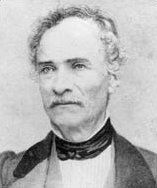
Back كيرياكوس بيتاكيس Arabic Κυριακός Πιττάκης Greek Kyriákos Pittákis French Kyriakos Pittakis Dutch Питтакис, Кирьякос Russian Киријакос Питакис Serbian Кіріакос Піттакіс Ukrainian
Kyriakos Pittakis | |
|---|---|
Κυριακός Πιττάκης | |
 Pittakis, c. 1850 | |
| Born | Kyriakos S. Pittakis 1798 Athens, Sanjak of Eğriboz, Ottoman Empire |
| Died | 4 November [O.S. 23 October] 1863 (aged 65)[1] Athens, Kingdom of Greece |
| Occupation | Archaeologist |
| Employer | Greek Archaeological Service |
| Known for | First Greek Ephor General of Antiquities; restoration of the Acropolis of Athens |
| Title | Ephor General (1843–1863) |
| Spouse | Aikaterini Makri |
| Children | At least 1 |
| Signature | |
Kyriakos S. Pittakis (also Pittakys; Greek: Κυριακός Σ. Πιττάκης; 1798 – 4 November [O.S. 23 October] 1863)[a] was a Greek archaeologist. He was the first Greek to serve as Ephor General of Antiquities, the head of the Greek Archaeological Service, in which capacity he carried out the conservation and restoration of several monuments on the Acropolis of Athens. He has been described as a "dominant figure in Greek archaeology for 27 years",[3] and as "one of the most important epigraphers of the nineteenth century".[4]
Pittakis was largely self-taught as an archaeologist, and one of the few native Greeks active in the field during the late Ottoman period and the early years of the Kingdom of Greece. He played an influential role in the early years of the Greek Archaeological Service and was a founding member of the Archaeological Society of Athens, a private body which undertook the excavation, conservation and publication of archaeological finds. He was responsible for much of the early excavation and restoration of the Acropolis, including efforts to restore the Erechtheion, the Parthenon, the Temple of Athena Nike and the Propylaia. As ephor of the Central Public Museum for Antiquities from 1836, and later as Ephor General, he was largely responsible for the conservation and protection of many of the monuments and artefacts then known from Ancient Greece.
Pittakis has been described as the last representative of the "heroic period" of Greek archaeologists.[5] He was prolific both as an excavator and as an archaeological writer, publishing by his own estimation more than 4,000 inscriptions. He has been praised for his extensive efforts to uncover and protect Greece's classical heritage, particularly in Athens and the adjacent islands, but criticised for his unsystematic and incautious approach. His reconstructions of ancient monuments often prioritised aesthetics over fidelity to the original, and were largely reverted after his death. He has also been accused of allowing his strong nationalist beliefs to influence his reconstruction of ancient monuments, and of distorting the archaeological record to suit his own beliefs.
- ^ Petrakos 1989, pp. 24–26.
- ^ Kiminas 2009, p. 23.
- ^ Petrakos 2011, p. 135.
- ^ Constantakopoulou 2008, p. 297.
- ^ Papazarkadas 2014, p. 405.
Cite error: There are <ref group=lower-alpha> tags or {{efn}} templates on this page, but the references will not show without a {{reflist|group=lower-alpha}} template or {{notelist}} template (see the help page).
© MMXXIII Rich X Search. We shall prevail. All rights reserved. Rich X Search